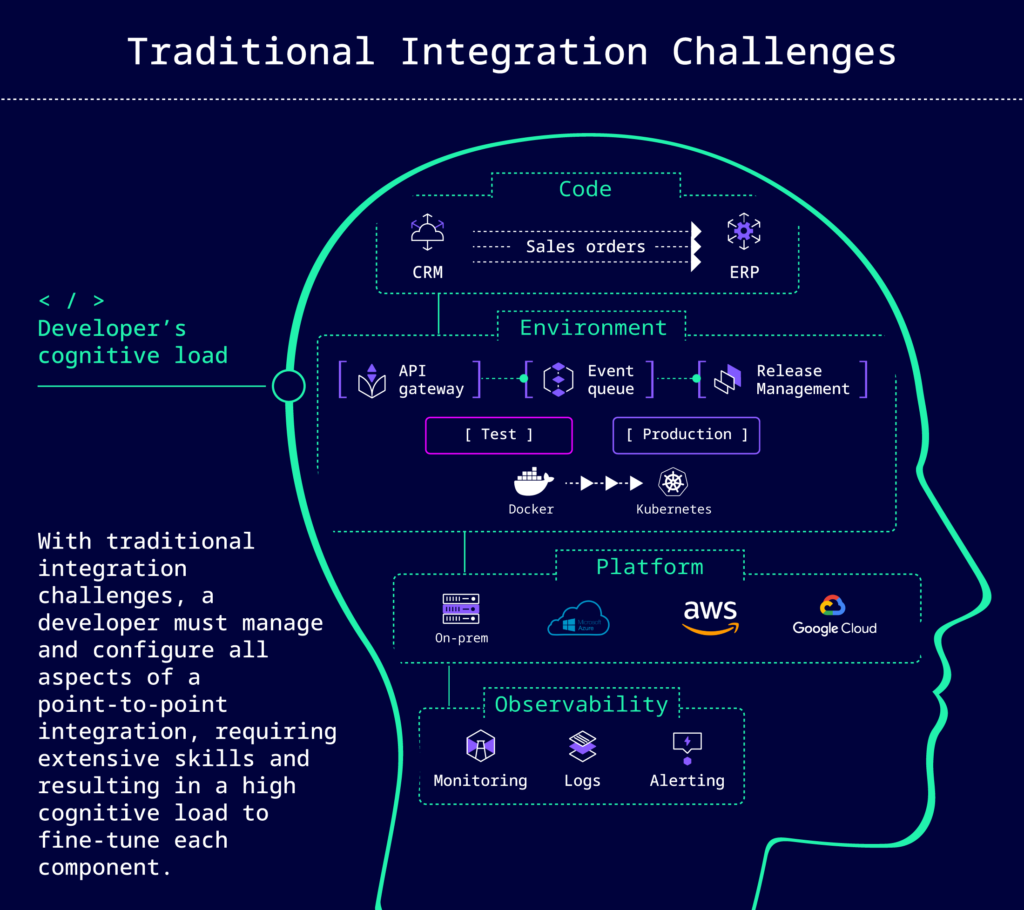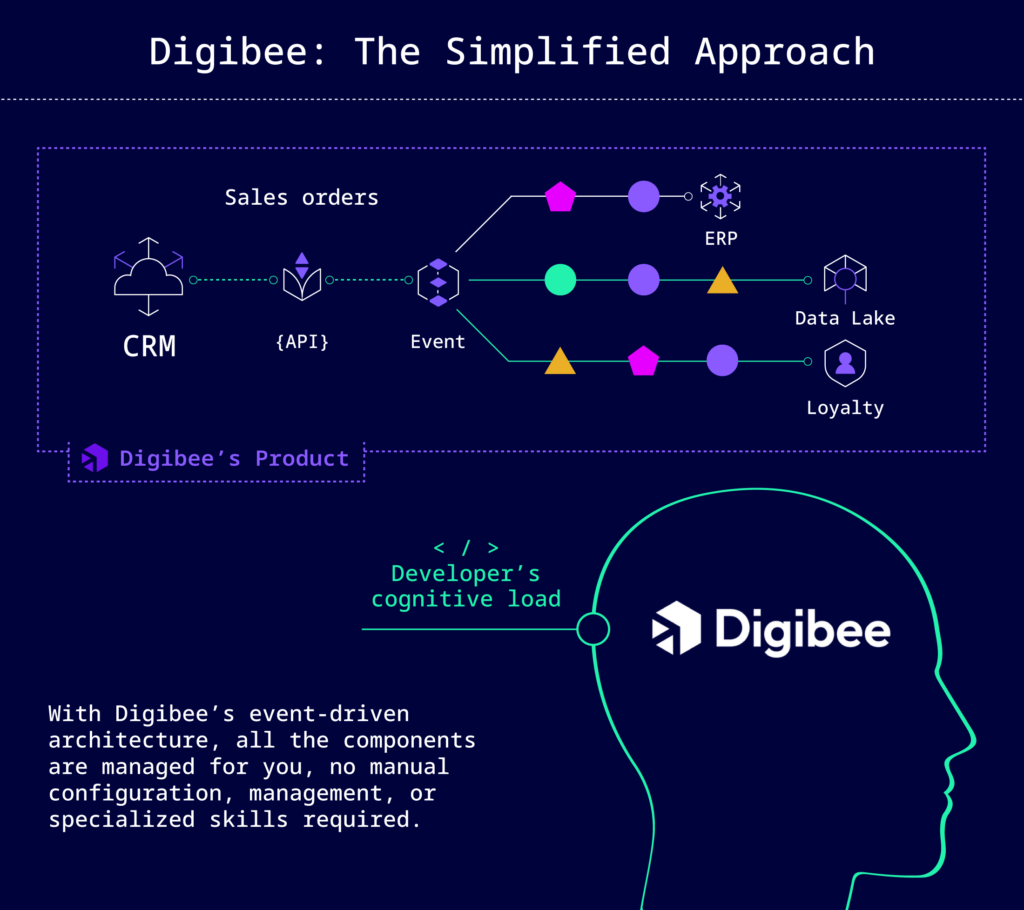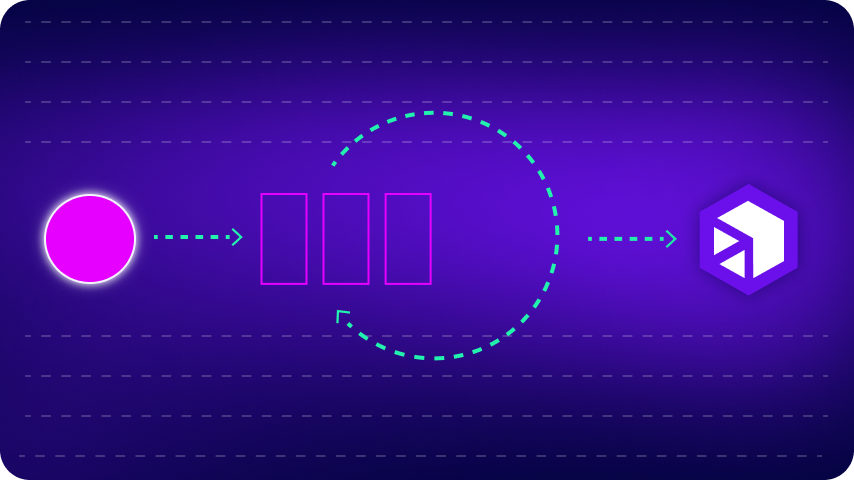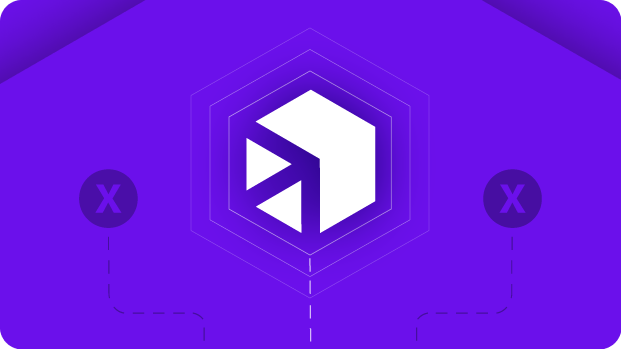July 16, 2024
No cenário digital acelerado de hoje, as organizações enfrentam o desafio constante de integrar diversas aplicações e sistemas de dados. As abordagens de integração tradicionais costumam trazer problemas de escalabilidade, flexibilidade e eficiência.
A arquitetura orientada a eventos (EDA) oferece uma alternativa interessante, prometendo estratégias de integração mais responsivas e adaptáveis. Neste post, você vai entender como a sua empresa pode aproveitar o poder da EDA para simplificar e aprimorar integrações complexas.
>> Agende uma demonstração personalizada com nossa equipe de especialistas e veja como o iPaaS da Digibee trará eficiência ao seu negócio.
O que é a arquitetura orientada a eventos (EDA)?
A arquitetura orientada por eventos representa uma mudança de paradigma em relação ao modelo tradicional de solicitação e resposta. Na EDA, os serviços comunicam-se por meio de eventos, em vez de chamadas diretas, promovendo baixo acoplamento e comunicação assíncrona.
Essa arquitetura permite que os sistemas sejam mais escaláveis e responsivos, pois os componentes podem reagir a eventos assim que ocorrem, sem aguardar respostas.
Desafios tradicionais de integração
A integração de sistemas empresariais envolve, em geral, plataformas complexas ou, então, ferramentas básicas de automação que carecem de escalabilidade. As empresas muitas vezes enfrentam problemas como:
- Interrupções: Podem ocorrer por uma variedade de razões, e muitas vezes os gargalos só são descobertos durante períodos de alta demanda, levando a uma série de falhas em cascata. Os integradores precisam decidir se planejam e implantam em torno das demandas de pico potenciais, estimando a capacidade certa para cada componente ou microsserviço. Isso resulta, em última análise, em um ajuste reativo conforme os problemas surgem, o que pode ser comparado a tentar alinhar os pneus enquanto o carro está em movimento.
- Complexidade: A configuração e manutenção complexas da infraestrutura de integração, como filas de eventos e balanceadores de carga, podem fazer com que os usuários passem tanto tempo gerenciando as ferramentas quanto as próprias integrações. Cada módulo da infraestrutura exige conhecimento especializado, além de configuração e monitoramento, apenas para aproveitar todos os recursos da plataforma de integração.
- Rigidez e Limitações: Com a constante mudança, arquiteturas inflexíveis dificultam adaptações rápidas às necessidades em evolução do negócio. A construção de integrações ponto a ponto e monolíticas resulta em integrações incapazes de atender a esses requisitos em mudança, tornando-se frequentemente lentas e difíceis de diagnosticar à medida que novos casos de uso são adicionados.

Digibee: a abordagem simplificada
A Digibee revoluciona a integração ao empregar uma arquitetura orientada a eventos que simplifica o processo de integração sem exigir configuração ou gerenciamento manual. Os principais benefícios incluem:
- Fila automática: A Digibee atribui uma fila dedicada para cada integração, aumentando a confiabilidade e permitindo o gerenciamento de aumentos repentinos de carga sem degradação de desempenho.
- Toda Integração é um Evento: Como cada integração possui sua própria fila, o reuso é incorporado. Qualquer integração pode ser acionada por um evento, permitindo que os desenvolvedores reutilizem workflows sem a necessidade de publicar uma API dedicada ou replicar código.
- Segurança melhorada: Ao utilizar filas, a Digibee garante que as chamadas para a plataforma sejam conectadas indiretamente aos contêineres que executam o código, aumentando assim a segurança. Mais sobre segurança de plataforma.
- Balanceamento de carga dinâmico: A Digibee ajusta automaticamente a carga entre vários contêineres que escalam conforme as demandas de tráfego, eliminando a necessidade de escalar manualmente e de um extenso planejamento de capacidade.
- Execução Isolada: Cada solicitação é processada em contêineres isolados com recursos dedicados, protegendo contra variabilidade de desempenho durante picos de demanda em arquiteturas modulares. Como cada execução já está protegida contra contenção de recursos, problemas de simultaneidade, perda de mensagens e falhas de software, os desenvolvedores não precisam arquitetar e gerenciar os recursos da plataforma.

Vamos ser técnicos: picos de tráfego e tarefas agendadas
No centro da eficiência operacional da Digibee está sua capacidade de lidar habilmente com solicitações de integração, especialmente em condições de carga variável. Veja mais detalhes sobre como a Digibee gerencia picos de tráfego e tarefas agendadas:
- Alocação e dimensionamento de recursos: A infraestrutura serverless da Digibee aloca dinamicamente recursos para lidar com tarefas à medida que são acionadas, sejam elas de tarefas agendadas ou eventos ad-hoc. Essa flexibilidade permite uma execução eficiente sem a necessidade de intervenção manual ou monitoramento constante por parte dos desenvolvedores.
- Dimensionamento automático e gerenciamento de carga: Considere uma API REST que enfrenta um aumento inesperado de tráfego. À medida que mais solicitações chegam, a Digibee escala automaticamente o número de contêineres para corresponder à carga recebida. As execuções permanecem isoladas em contêineres dedicados, eliminando a contenção de recursos e evitando a sobrecarga de qualquer contêiner único. A Digibee permite definir limites superiores para o escalonamento, a fim de evitar o uso excessivo de recursos que possa impactar sistemas de backend ou gerar custos inesperados.
- Balanceamento de carga inteligente e gerenciamento de capacidade: Em situações em que é necessário gerenciar a carga sem sobrecarregar a capacidade do sistema, a Digibee realiza o balanceamento de forma inteligente entre os contêineres disponíveis. Assim que a demanda diminui, a Digibee reduz o número de contêineres ativos, desligando a capacidade não utilizada. Isso não apenas otimiza o uso de recursos, mas também reduz custos, garantindo que apenas os recursos necessários estejam em uso a qualquer momento.
Simplifique os desafios complexos das integrações modernas
A arquitetura orientada a eventos da Digibee fornece uma solução robusta para os desafios complexos das integrações modernas. Ao automatizar os principais aspectos do gerenciamento de integração, a Digibee permite que as organizações se concentrem mais na inovação e menos nas complexidades operacionais.
Explore o potencial transformador da integração orientada a eventos com o Digibee. Saiba mais sobre nosso produto or fale com nossa equipe para ver como você pode simplificar seu cenário de integração e impulsionar o sucesso dos negócios.








